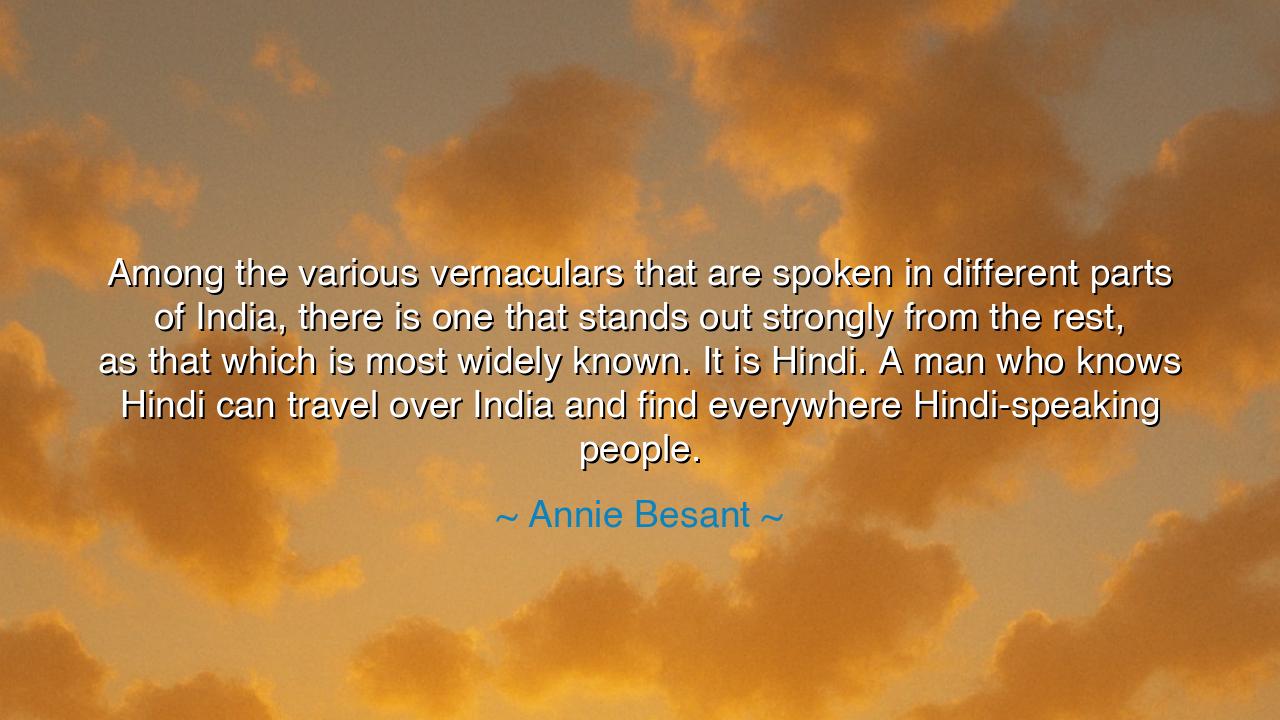
Among the various vernaculars that are spoken in different parts
Among the various vernaculars that are spoken in different parts of India, there is one that stands out strongly from the rest, as that which is most widely known. It is Hindi. A man who knows Hindi can travel over India and find everywhere Hindi-speaking people.






Annie Besant, that fearless seeker of truth and champion of India’s destiny, once declared: “Among the various vernaculars that are spoken in different parts of India, there is one that stands out strongly from the rest, as that which is most widely known. It is Hindi. A man who knows Hindi can travel over India and find everywhere Hindi-speaking people.” Though spoken in her own time of service and reform, these words still ring with meaning, for they speak to the power of language as a bridge across vast distances, a thread binding the diversity of a people into shared understanding.
When Besant speaks of Hindi, she does not diminish the richness of other tongues, for India is a land woven of countless dialects, each carrying the memory of kings, poets, and common folk. But she recognizes a truth of her age: that amid this great chorus, one language was spreading as a unifying current. To know Hindi was to hold a key, to unlock doors in villages and cities alike, to move across the breadth of India and find common ground with strangers. It was not merely speech—it was connection, and connection is the seed of unity.
The ancients knew the power of a shared language. In the time of Alexander, the spread of Greek bound together lands from Egypt to Persia, enabling scholars to share knowledge and merchants to exchange goods. In Rome, Latin was the tongue of law and order, carrying the empire’s authority into distant provinces. And in India itself, Sanskrit once held a place of sacred and scholarly prestige, carrying mantras, philosophies, and poetry across centuries. Each of these examples teaches us that when people share words, they can share also ideas, trust, and belonging.
One may recall also the life of Mahatma Gandhi, who understood the necessity of reaching the people in their own speech. While educated in English and steeped in Gujarati, he chose to write and speak often in Hindi, so that his message of freedom and unity could echo across the land. His use of Hindi did not erase other tongues, but it allowed the dream of independence to flow swiftly from one province to another, carried in a language many could understand. In this way, Besant’s insight was confirmed by history itself: a shared language can be a vessel for shared purpose.
But Besant’s words also whisper a deeper wisdom. For though she speaks of travel across India, she points to more than physical movement. To speak another’s language is to step into their world, to honor their thought, to share in their joys and sorrows. A traveler who speaks the tongue of the people is no longer a stranger; he is a guest, welcomed as kin. Thus, language becomes not only a tool of passage, but of peace. It is a way to dissolve the barriers of difference and to reveal the humanity that lies beneath all accents.
The lesson for us, then, is profound: if we would unite, we must learn to speak in ways that others can receive. Whether it be through Hindi in India, or any common tongue in other lands, language is the gateway to trust. And beyond words themselves, we must seek to speak the language of kindness, of humility, of respect. For even where tongues differ, a gentle spirit communicates more than grammar ever could.
Therefore, let this wisdom be your guide: honor the many languages of the world, for each is a jewel of culture, but also seek the shared speech that allows hearts to meet. If you travel, learn even a few words of the local tongue, and you will find that strangers become friends. If you seek unity in your own land, speak to people not only with lofty words but with words they know and feel. In this way, as Besant taught, you will find that no place is foreign, and no person is wholly distant, for language binds us as surely as blood.
So, O listener, remember Annie Besant’s insight: in a land of many voices, Hindi was once the bridge across provinces. And in the greater world, language—whether of words or of the heart—is still the bridge across humanity. Build that bridge wherever you go, and you will find that you are never truly a stranger, for you carry within you the key to fellowship, understanding, and peace.






AAdministratorAdministrator
Welcome, honored guests. Please leave a comment, we will respond soon